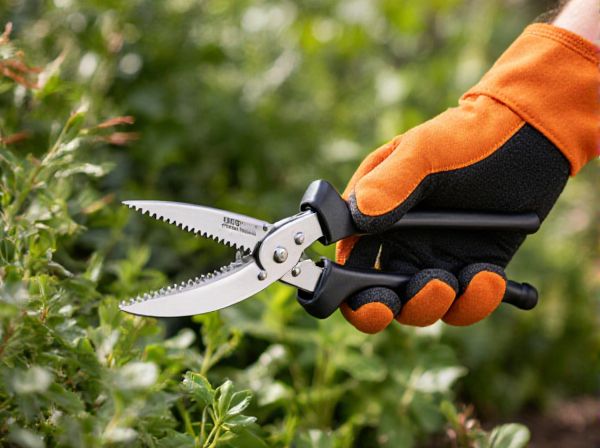
Bypass pruners vs anvil pruners Illustration
Bypass pruners feature two sharp blades that slide past each other like scissors, providing cleaner cuts ideal for live plants and green branches, minimizing damage and promoting faster healing. Anvil pruners have a single sharp blade that cuts against a flat metal surface, making them better suited for tougher, dead branches but often causing more crushing damage to live stems. Choosing between bypass and anvil pruners depends on the type of pruning task and plant material to ensure precision and plant health.
Table of Comparison
| Feature | Bypass Pruners | Anvil Pruners |
|---|---|---|
| Cutting Mechanism | Sharp curved blades pass by each other like scissors | Single straight blade presses onto flat surface (anvil) |
| Best For | Live green branches and precise cuts | Dead, dry wood and tougher stems |
| Cut Quality | Clean cuts, minimal damage to plant | Crushing cuts, may damage delicate plants |
| Maintenance | Requires regular sharpening | Lower maintenance, less frequent sharpening |
| Durability | High, suitable for frequent use | Robust, effective for tough materials |
| Price Range | Moderate to high | Low to moderate |
Introduction to Bypass and Anvil Pruners
Bypass pruners feature two sharp blades that pass each other like scissors, making precise, clean cuts ideal for live plants and green branches. Anvil pruners consist of a single sharp blade that closes onto a flat anvil surface, suitable for cutting dry or dead wood with their crushing action. Understanding these tool designs helps gardeners select the appropriate pruner for specific pruning tasks, ensuring healthier plant maintenance and efficient cutting.
Design and Mechanism Differences
Bypass pruners feature two curved blades that slide past each other, resembling scissors, allowing clean cuts ideal for live plant stems. Anvil pruners operate with a single sharp blade pressing down onto a flat, anvil-like surface, suited for tougher, dead branches but can crush softer plant material. The design differences directly influence cutting precision and plant health, with bypass pruners promoting cleaner wounds and anvil pruners providing greater leverage for heavy-duty tasks.
Best Uses for Bypass Pruners
Bypass pruners excel at precision cutting of live plants, making them ideal for pruning green branches, flowers, and soft stems. Their sharp, curved blades slide smoothly past each other, reducing damage and promoting faster plant healing. These pruners are best used for detailed gardening tasks, such as shaping shrubs and harvesting herbs.
Ideal Applications for Anvil Pruners
Anvil pruners are ideal for cutting through thick, dry, or dead branches due to their single blade that presses against a flat metal surface, providing powerful crushing cuts. They excel in pruning tougher woody stems and branches up to 1 inch in diameter, making them suitable for heavy-duty gardening tasks and hedge trimming. Their cutting mechanism reduces the effort required for dense or hardened plant material, ensuring efficient and clean cuts without frequent blade sharpening.
Cutting Performance Comparison
Bypass pruners deliver clean, precise cuts by using two curved blades that pass by each other, making them ideal for live branches and reducing plant damage. Anvil pruners feature a straight blade that cuts against a flat surface, often crushing stems and causing more tearing, which can hinder plant health. For optimal cutting performance and healthier pruning results, bypass pruners are preferred, especially on green, live wood.
Pros and Cons of Bypass Pruners
Bypass pruners feature two sharp blades that pass by each other, providing clean cuts ideal for live plants and reducing the likelihood of crushing stems, which promotes faster healing and less damage. These pruners excel in precision cutting but may require more frequent sharpening due to blade wear. The main drawback is their limited effectiveness on tougher, thicker branches compared to anvil pruners, which can crush or deform soft plant material.
Advantages and Disadvantages of Anvil Pruners
Anvil pruners feature a single straight blade that cuts against a flat surface, providing strong cutting power ideal for tough, dry branches. Their advantage lies in simplicity and strength, allowing clean cuts on dead wood without requiring multiple motions. However, anvil pruners tend to crush softer or live branches, resulting in less precise cuts and potential plant damage compared to bypass pruners.
Choosing the Right Pruner for Your Garden
Bypass pruners feature two sharp blades that pass by each other, providing clean cuts ideal for live branches and promoting healthy plant growth. Anvil pruners have a single sharp blade that crushes against a flat edge, making them better suited for cutting dead or woody stems. Selecting the right pruner depends on the type of plants in your garden and the precision required for pruning tasks.
Maintenance and Care Tips
Bypass pruners require regular sharpening to maintain clean cuts and prevent plant damage, while anvil pruners benefit from occasional blade alignment to ensure proper function. Both types should be cleaned after each use to remove sap and debris, preventing rust and corrosion. Applying a light oil to the pivot area and blades enhances smooth operation and extends tool lifespan.
Final Verdict: Which Pruner Suits Your Needs?
Bypass pruners deliver clean, precise cuts ideal for live branches and delicate plants, reducing damage and promoting healthy regrowth, while anvil pruners excel at cutting dead wood and tougher stems with a single straight blade pressing against a flat surface. Gardeners seeking accuracy and plant health benefit from bypass pruners, especially for pruning roses, shrubs, and fruit trees, whereas those handling heavier, woodier materials might prefer the strength and simplicity of anvil pruners. Choosing the right pruner depends on plant type, pruning frequency, and desired cut quality for efficient yard maintenance.
Bypass pruners vs anvil pruners Infographic

 gardendif.com
gardendif.com